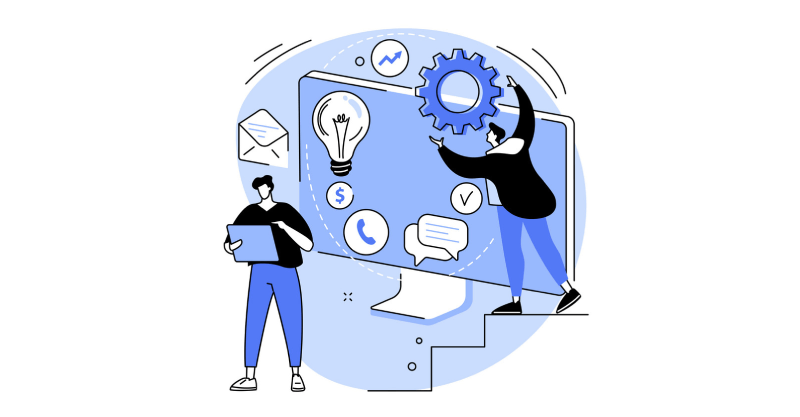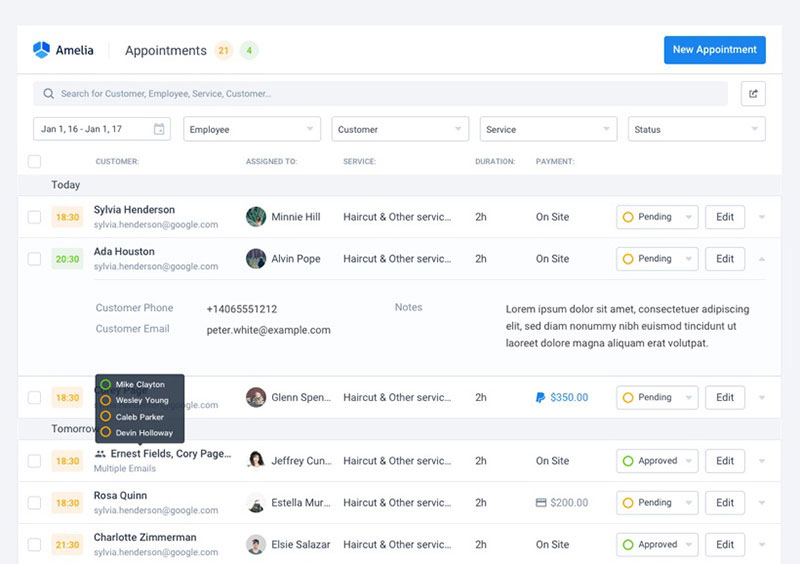For service businesses, such as spas, salons, medical clinics, consulting firms, and other appointment-based organizations, effective employee efficiency is crucial to ensuring smooth operations, meeting customer demands, and maximizing revenue.
With appointments to manage, high-quality service to provide, customer satisfaction to uphold, and various tasks to handle, optimizing employee efficiency becomes paramount.
Efficient employees in service businesses are quick to manage customer inquiries, resolve issues, complete tasks, and deliver outstanding service. This leads to increased customer loyalty, positive word-of-mouth, and improved business performance. Therefore, finding ways to enhance employee efficiency is a key priority for every service-based business.
In this article, we’ll explore 10 practical strategies to boost employee efficiency in appointment-based businesses.
So, let’s dive in!
How to Improve Employee Efficiency in Your Workplace?
Align tasks with expertise
Matching tasks with employees’ skills and abilities is a crucial element in maximizing employee efficiency and productivity. When employees are assigned tasks that align with their expertise and capabilities, they are more likely to perform their job effectively and efficiently. This is especially important in the service industry.
For instance, assign employees with excellent customer service to handle customer interactions. They should be the ones to greet customers, manage inquiries, and resolve any issues or concerns promptly.
If you run a salon, you know that each employee has their own special talent. Make sure to assign a hair stylist with expertise in coloring to appointments that involve color treatments. On the other hand, leave facial appointments to an aesthetician with specialized knowledge in facials. This’ll result in faster and more efficient service delivery, higher customer satisfaction, and increased repeat business.
Also, administrative tasks, such as managing paperwork, maintaining records, and handling billing and invoicing, are ideal for employees with strong administrative skills. These employees can efficiently handle administrative duties, ensuring the paperwork and documentation are accurate, up-to-date, and well-organized.
How this approach helps your business?
By aligning tasks with employees’ skills, appointment-based businesses can leverage their team’s strengths and abilities, resulting in improved productivity and performance. Employees skilled in their assigned tasks are likely to complete them more efficiently and effectively, resulting in smoother operations, better time management, and enhanced customer service.
In addition, matching tasks with skills can also boost employee morale and job satisfaction. When employees are given tasks that align with their strengths and expertise, they are more likely to feel competent and confident in their roles. This can lead to increased job satisfaction, higher levels of motivation, and a sense of ownership and pride in their work.
Just ensure you regularly assess your employees’ skills and assign tasks accordingly. Only then will your staff work to their full potential, resulting in improved employee efficiency and productivity in the workplace.
Delegate tasks properly

Delegating tasks is a game-changer for boosting employee efficiency in appointment-based businesses. It’s all about figuring out which tasks can be assigned to the right employees based on their skills and workload.
Delegating tasks means letting employees take charge of their responsibilities and make decisions in their own domain. This not only lightens the load for you but also taps into the unique strengths and abilities of each employee, leading to improved efficiency and productivity.
Making sure communication is crystal clear is key. You need to explain the expectations, goals, and desired outcomes of the delegated tasks to employees in a way that’s easy to understand. Providing the right resources, tools, or support is also important. That way, employees have what they need to get the job done right.
And, of course, keeping tabs on progress with regular check-ins is a must. You can offer feedback, provide extra guidance, and make adjustments as needed to keep things on track. Just ensure you always stay objective when assessing your employees’ performance.
Set clear expectations
Setting clear expectations is like laying the groundwork for success. It’s like having a roadmap that guides your team toward achieving their goals and delivering exceptional service to your customers.
It’s crucial to communicate expectations to your team in a clear and concise manner. This includes outlining the goals, objectives, and responsibilities associated with each task or role. Be specific about what you expect from your team members, including the quality of work, deadlines, and any other relevant details.
One effective approach to establishing clear expectations is to involve your team in the process. Encourage open communication and feedback, and give your team members the opportunity to ask questions or seek clarification. This fosters a collaborative environment where everyone is on the same page and working towards the same goals.
It’s also important to ensure that expectations are realistic and achievable. Avoid setting unrealistic or overly ambitious expectations that can lead to stress, burnout, or disappointment. Instead, set expectations that are challenging yet attainable, taking into consideration the skills, abilities, and workload of your team members.
Regularly review and reinforce expectations with your team. Provide feedback on their progress, acknowledge their achievements, and address any areas that may need improvement. Be approachable and open to discussions, and provide guidance and support when needed.
What are the benefits?
Clear expectations help your team understand what is expected of them, which can prevent misunderstandings, confusion, and mistakes. It sets a standard for performance and accountability, which can lead to better outcomes and results.
Clear expectations benefit not only your team but also your customers. When your team knows what is expected of them, they are more likely to deliver consistent and high-quality service, which results in satisfied customers who keep coming back.
Communicate effectively

Effective communication is like the secret sauce that keeps your team running like a well-oiled machine.
Communicate with your team with clarity and precision. No need for fancy jargon or complicated talk, just keep it simple and easy to understand. Break down tasks, set clear deadlines, and provide all the details your team needs to get the job done right. Whether it’s through face-to-face meetings, emails, project management tools, or even good old sticky notes, choose the right communication channel that fits the nature of the information you’re sharing.
Keep in mind that communication is not just about talking, it’s also about listening. Show your team how much you appreciate them by actively listening to their concerns, questions, and feedback. Put down your phone, close that laptop, and give them your full attention. Ask clarifying questions to make sure you understand what they’re saying, and provide feedback or reassurance as needed. Let them know that their voice matters and that you value their input.
Being approachable and open to questions is also essential. Keep that door (whether it’s virtual or physical) wide open for your team to come to you with their thoughts, ideas, or concerns. Create an environment where they feel comfortable expressing themselves without fear of judgment or reprisal. Encourage open and honest communication, and make sure your team knows that their opinions and ideas are valued and appreciated.
How to keep the communication going?
Regular team meetings, one-on-one check-ins, and feedback sessions are fantastic opportunities for fostering open communication and teamwork vibes. These interactions provide a platform for team members to share their thoughts, insights, and suggestions. It’s also a chance for you to provide feedback, recognize their efforts, and address any concerns they may have.
Keep the communication light, friendly, and engaging, and create a collaborative atmosphere where everyone feels heard and respected. By doing so, you might increase your team’s productivity by 25%.
Motivate, encourage, and incentivize your team
Incentives are a powerful tool to motivate and reward team members for their hard work, dedication, and outstanding performance. When employees feel valued and appreciated, they are more likely to go the extra mile, deliver exceptional service, and contribute to the success of your appointment-based business.
Firstly, make sure to recognize and appreciate your team members’ efforts and achievements. Acknowledge their hard work, dedication, and contributions publicly and privately. A simple “thank you” or a word of praise can go a long way in boosting employee morale and motivation.
In addition, empower your team by giving them autonomy and ownership over their work. Trust them to make decisions and take responsibility for their tasks. Encourage innovation and creativity, and provide opportunities for them to contribute their ideas and suggestions. When employees feel empowered, they are more likely to be motivated and engaged in their work.
Another great idea is to foster team spirit and camaraderie by organizing team-building activities. This can include team lunches, outings, or bonding exercises. These activities can help strengthen relationships among team members, boost morale, and create a positive and cohesive team culture.
Moreover, recognize the importance of work-life balance and provide flexibility in scheduling or remote work options, if feasible. This can help reduce stress, promote well-being, and show your team that you value their personal lives as well.
Finally, implement an incentive or reward program to recognize and reward outstanding performance. Make sure the incentives are aligned with the goals of your business and are fair and consistent.
What kind of incentives can you offer?
Monetary incentives: You can opt to reward an employee through bonuses, commissions, profit-sharing, or performance-based pay. For example, you can offer a commission or bonus for team members who meet or exceed sales targets or achieve exceptional customer service scores.
Gift cards or vouchers: Gift cards or vouchers to popular retailers, restaurants, or entertainment venues can be an appealing incentive for team members.
Extra time off: Extra time off allows employees to recharge, relax, and rejuvenate, which can help improve their work-life balance and job satisfaction. This time off can include a day off, extended weekends, or additional vacation days.
Recognition and awards: Recognize exceptional performance by giving awards or certificates. These can include “Employee of the Month” or “Top Performer” awards, which can be displayed in the workplace or shared on social media to highlight the employee’s achievements and boost their morale.
Special privileges or perks: Offering reserved parking spots, flexible work arrangements, or access to exclusive amenities can make team members feel valued and appreciated.
Team-based incentives: Incentivizing teamwork can foster collaboration among team members. For example, you can offer team-based bonuses or rewards for achieving collective goals or completing projects successfully.
Invest in employee development

Always aim to provide opportunities for learning, growth, and advancement for your team members. Not only can such an approach do wonders for employee efficiency, but it can also result in several other benefits for your business.
Employee development programs, such as workshops, webinars, or on-the-job training, can help team members enhance their skills and knowledge. For instance, a dental clinic could provide training on the latest dental techniques for their dental assistants or a salon could offer workshops on advanced hair styling techniques for their stylists.
When employees feel that their employer is invested in their development, it can boost their motivation and engagement. This results in improved job performance and productivity, leading to better customer service and outcomes.
Moreover, providing opportunities for employee development can help retain top talent. For instance, a medical clinic could offer leadership development programs for its clinic managers, preparing them for higher-level roles in the future and building them up with strong leadership traits. This can reduce turnover rates and the associated costs of hiring and training new employees, ensuring stability and continuity in business operations.
Additionally, investing in employee development can contribute to effective succession planning within the organization. For example, a spa could identify and groom high-potential employees for future leadership roles, providing them with training and mentoring opportunities.
As for the latter one, with the right mentoring software, these high-potential employees can receive structured guidance and development through mentoring programs.
This can ensure a smooth transition of leadership and continuity of operations, even during times of organizational change.
Also, employee development programs can foster innovation and creativity. For instance, a fitness center could offer training on the latest fitness trends or nutrition practices for their fitness instructors, encouraging them to come up with new ideas and approaches to engage clients. This can lead to improved services and customer satisfaction, setting the business apart from competitors.
Automate time-consuming tasks and let employees focus on their work

Automating repetitive tasks can greatly benefit appointment-based businesses by increasing employee efficiency, reducing errors, and saving valuable time and resources.
Manual processes, such as scheduling appointments, managing calendars, and sending appointment reminders, can be labor-intensive and prone to human errors. By automating these tasks, businesses can streamline their operations and free up their employees’ time for more strategic and valuable activities.
Appointment booking and scheduling, keeping track of the calendar, managing customers, managing employees and tracking their work schedule, handling payments, and monitoring KPIs and performance are the tasks every service-business owner knows and dreads. They eat away at time and resources, leaving both you and your employees exhausted to focus on what really matters – the business itself.
But what if there is a solution that handles all these tasks for you?
That solution is called Amelia.
How can Amelia help you?
Amelia is a powerful WordPress booking plugin designed to help service-based business owners and managers automate their business processes.
Here’s what Amelia takes off your plate:
- Online appointment booking: Amelia can handle appointment scheduling and booking tasks, allowing customers to book appointments online at their convenience. This eliminates the need for manual appointment booking and scheduling, reducing the administrative burden on staff and ensuring accurate and error-free bookings.
- Appointment reminders: Send automated confirmation texts and reminders to customers via email or text messages to reduce no-shows and last-minute cancellations. This saves time for staff who would otherwise have to manually send reminders and helps ensure that appointments are kept as scheduled.
- Calendar management: Amelia can manage calendars and appointments in real time, helping to avoid scheduling conflicts and ensuring smooth coordination among team members. Amelia can also handle rescheduling, cancellations, and appointment reassignments automatically, reducing the need for manual calendar management.
- Payment processing: Thanks to its integrations with the most popular payment getaways, Amelia lets your customers pay for their appointments online.
- Reporting and analytics: Amelia generates accurate and up-to-date reports, providing insights and analytics on appointment bookings, customer trends, and business performance.
So, why wait? Try Amelia right now and level up your employee efficiency!
Give your employees time to recharge
Making time for breaks during work hours and employee shifts is essential for maintaining productivity, ensuring employee well-being, and promoting a healthy work-life balance. Breaks allow employees to rest, recharge, and return to work with renewed energy and focus.
Here are some ways you can encourage and facilitate breaks:
Establish scheduled breaks
You can establish scheduled break times during work hours or employee shifts to ensure that employees have dedicated time for breaks. For example, employees can have a designated 15-minute break in the morning and afternoon, or a longer lunch break to relax and rejuvenate.
Provide rest areas
These areas can be equipped with comfortable seating, refreshments, and amenities to help employees relax and recharge during their breaks.
Be flexible
You can offer flexibility in breaks, allowing employees to take breaks when needed, within reasonable limits. Some employees may prefer shorter breaks and like to take them more frequently, while others take longer breaks in one go.
Encouraging physical activity
Encouraging employees to engage in physical activity during their breaks can help promote health and well-being. For example, providing opportunities for short walks stretches, or other physical activities can help employees relax and return to work with increased energy and focus.
Lead by example
Set a positive example by taking regular breaks yourself and encouraging your team members to do the same. When employees see their leaders prioritizing and taking breaks, it creates a positive culture that values employee well-being and encourages the practice of taking breaks.
Communication and awareness
Creating awareness about the importance of breaks and communicating the expectations around taking breaks can encourage employees to prioritize and make time for breaks. This can be done through training, reminders, and regular communication about the benefits of breaks and the company’s policies on breaks.
Provide your employees with time off

Giving your employees enough time off can increase their efficiency in several ways.
Taking time off enhances work-life balance, reducing burnout and absenteeism. It acknowledges that employees have personal lives and commitments outside of work, and it allows them to take time to attend to those responsibilities. When employees are able to strike a balance between their work and personal life, they are likely to be more satisfied and motivated in their jobs.
Moreover, time off fosters creativity and innovation by providing employees with opportunities to explore interests. When employees are well-rested, they are more likely to return to work with increased energy, focus, and motivation. What’s more, it improves employee engagement and retention, as well as team morale and collaboration.
Organizations that prioritize time off for employees are likely to see improved productivity and efficiency in the long run.
Offer flexible working hours
Offering flexible working hours to employees can be a valuable approach to enhancing their efficiency and productivity.
Flexible working arrangements and work schedule types, such as flextime, telecommuting, or compressed workweeks, provide employees with the flexibility to choose when and where they work, based on their personal preferences and responsibilities. This flexibility can help them better manage their work-life balance, reduce commuting time, and accommodate personal commitments. Thai results in improved job satisfaction and morale.
When employees have control over their work schedule, they may be more motivated, engaged, and committed to their work. They may also experience lower levels of stress and burnout, leading to increased productivity and efficiency.
Additionally, flexible working hours can help attract and retain top talent, as it demonstrates an employer’s commitment to supporting the needs and well-being of their employees.
Why Is Employee Efficiency So Important?
Employee efficiency is crucial for achieving success in a competitive market. This is especially true if your business belongs to the service industry.
By implementing strategies such as aligning tasks with employees’ expertise, providing incentives, automating manual processes, creating a clear time-off policy, and offering flexible working hours, businesses can create a positive work environment that fosters employee engagement, motivation, and productivity.
Investing in employee development, communicating, and prioritizing employee well-being are essential aspects of improving efficiency in the workplace.
When employees feel valued, supported, and empowered, they are more likely to perform at their best. This leads to smoother operations, higher customer satisfaction, increased repeat business, and overall business success.
If you enjoyed reading this article, check out the following ones:
- The Best Employee Scheduling Apps
- How to Create a Work Schedule That Maximizes Productivity
- The Best Small Business Employee Scheduling Solutions


